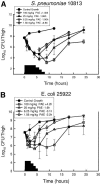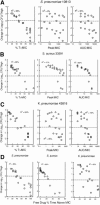Pharmacodynamics of a new cephalosporin, PPI-0903 (TAK-599), active against methicillin-resistant Staphylococcus aureus in murine thigh and lung infection models: identification of an in vivo pharmacokinetic-pharmacodynamic target
- PMID: 16569855
- PMCID: PMC1426945
- DOI: 10.1128/AAC.50.4.1376-1383.2006
Pharmacodynamics of a new cephalosporin, PPI-0903 (TAK-599), active against methicillin-resistant Staphylococcus aureus in murine thigh and lung infection models: identification of an in vivo pharmacokinetic-pharmacodynamic target
Erratum in
- Antimicrob Agents Chemother. 2014 Apr;58(4):2489. Dosage error in article text
Abstract
PPI-0903 is a new cephalosporin with broad-spectrum activity, including beta-lactam-resistant Streptococcus pneumoniae and Staphylococcus aureus. We used the neutropenic murine thigh and lung infection models to examine the pharmacodynamic characteristics of PPI-0903. Serum drug levels following four fourfold-escalating single doses of PPI-0903 were measured by microbiologic assay. In vivo postantibiotic effects (PAEs) were determined after doses of 1.56, 6.25, 25, and 100 mg/kg of body weight in mice infected with S. pneumoniae ATCC 10813, S. aureus ATCC 29213, or Escherichia coli ATCC 25922. Dose fractionation studies over a 24-h dose range of 0.39 to 1,600 mg/kg were administered every 3, 6, 12, or 24 hours. Nonlinear regression analysis was used to determine which pharmacokinetic-pharmacodynamic (PK-PD) index (total and free 65% drug) best correlated with CFU/thigh at 24 h. Similar to other beta-lactam antibiotics, PPI-0903 produced short to modest in vivo PAEs with either S. pneumoniae or E. coli. The percent time that serum concentrations were above the MIC (%T>MIC) was the PK-PD index that best correlated with efficacy (R2=84 to 88% for the three organisms, compared with 9 to 41% for peak/MIC and 30 to 82% for the area under the concentration-time curve/MIC). In subsequent studies we used the neutropenic murine thigh infection model to determine if the magnitude of the free-drug % T>MIC needed for efficacy of PPI-0903 varied among pathogens (including resistant strains). Mice infected with one of five isolates of S. pneumoniae, four isolates of S. aureus, or four gram-negative bacilli were treated for 24 h with 0.10 to 400 mg/kg of PPI-0903 every 6 h. A sigmoid dose-response model was used to estimate the doses (mg/kg/24 h) required to achieve a net bacteriostatic affect over 24 h and to produce a reduction in the burden of organisms from the start of therapy by 1 and 2 log10 CFU/thigh. MICs ranged from 0.008 to 1 microg/ml.Mean free-drug %T >MICs the standard deviation associated with the static effect endpoint for S. pneumoniae, S. aureus, and gram-negative isolates were 39±9, 26±8, and 47±8, respectively [corrected]. Methicillin and penicillin resistance did not alter the magnitude of free-drug %T>MIC required for efficacy. The free-drug %T>MIC necessary for efficacy was slightly reduced in animals with normal neutrophil counts. Treatment effect was similar in both the thigh and lung infection models. The pharmacodynamic characteristics of PPI-0903 are similar to those of other compounds within the cephalosporin class.
Figures











References
-
- Ambrose, P. G., R. Quintiliani, and N. Chin. 1997. Continuous vs intermittent infusion of cefuroxime for the treatment of community-acquired pneumonia. Infect. Dis. Clin. Pract. 7:463-470.
-
- Andes, D., and W. A. Craig. 2002. A critical review of animal model pharmacokinetics and pharmacodynamics. Int. J. Antimicrob. Agents 19:261-268. - PubMed
-
- Craig, W. A. 1998. Pharmacokinetics and pharmacodynamics of antibiotics in mice and men. Clin. Infect. Dis. 26:1-12. - PubMed
-
- Craig, W. A. 1995. Interrelationship between pharmacokinetics and pharmacodynamics in determining dosage regimens for broad-spectrum cephalosporins. Diagn. Microbiol. Infect. Dis. 22:89-96. - PubMed
MeSH terms
Substances
LinkOut - more resources
Full Text Sources
Medical
Molecular Biology Databases
Miscellaneous

